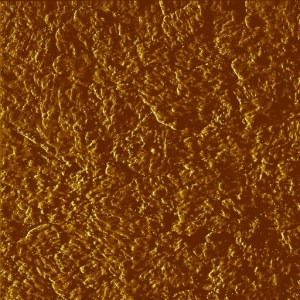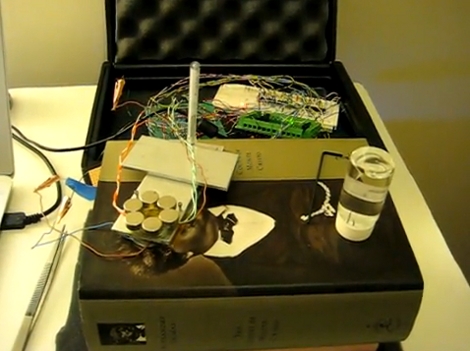This is not an artist’s rendering, nor a physics simulation. This device held together with hardware-store MDF and eyebolts and connected to a breadboard, is taking pictures of actual atomic structures using actual measurements. All via an 80¢ piezo buzzer? Madness.

This apparent wizardry is called a scanning tunneling microscope which takes advantage of quantum tunneling. The device brings a needle atomically close to the object to be measured (by hand), applying a small voltage (+-15V), and stopping when it starts to conduct. Depending on the distance between the tip and the target, the voltage varies and does so precisely enough to identify whether an atom is underneath or not, and by how much.
The “pictures” are not photographs like a camera might take from a standard optical microscope, however they are neither guesses nor averages. They are representations of real physical measurements of specific individual atoms as they exist on the infinitesimal area being probed. It “sees” by measuring small voltage changes. Another difference lies in the “scanning.” The probe examines atoms the way one would draw ASCII images – single pixels at a time until an entire atom was drawn. Note that the resolution – as shown in the pictures – is sub-atomic. Sizes of atoms are apparent as are the distances between them. In this they are closer related to the far more expensive Scanning Electron Microscope technology, but are 10-100x zoomier; resolving 0.00000000001m, or 0.00000000039″.

One would presume that dealing with actual atoms requires precision machining vast orders of magnitude beyond the home hobbyist but, no. Any one of us could make this at home or in our hackerspaces, for nearly free. Apparently even sharpening a tip to a single atom is, as [Dan] says “not as hard to achieve as you might think!” You take some tungsten wire and pull on it as you cut so that it shatters diagonally. There are better ways he suggests, but that method is good enough.
The ordinary piezo buzzer that is key to the measurement is chopped into quadrants with an ordinary X-Acto knife by hand. Carefully, because it is fragile, but, nothing more to it than that. There are two better and common methods but they cost hundreds of dollars, not 80 cents. It should be carefully glued since soldering heat will damage it, but, [Dan] soldered his anyway because it was easier. Continue reading “Cheap DIY Microscope Sees Individual Atoms”











